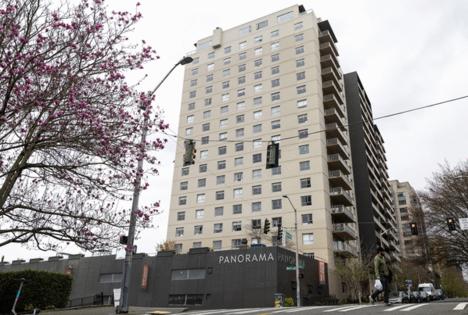Seattle used to have affordable housing. What happened to it?
Published in Home and Consumer News
SEATTLE — In 2014, new owners purchased Panorama House, an 18-story building on First Hill, and to renovate the decades-old apartments, they kicked out 200 tenants, many of them elderly and retired.
Explicitly or not, they were making room for a deluge of younger renters moving to a city unequipped to fit newcomers. Many transplants had an advantage over Panorama's old tenants: They could pay more.
After adding high-speed internet, a fitness center and a tiki-themed lounge, Panorama's owners reopened the building with rents nearly doubled.
What happened to Panorama was happening around the city. The price of what used to be affordable housing was skyrocketing out of range for people working minimum wage jobs, surviving on fixed incomes or dealing with physical disabilities or addiction.
During the 2010s, Seattle lost more than 14,000 rental units considered affordable for the lowest income households. That was a major driver — perhaps the biggest reason — of why the number of people living on the streets doubled in this period, experts say.
"It's just pitting people with limited resources against one another for not enough housing," said Gregg Colburn, a housing and homelessness researcher at the University of Washington. "And ultimately, there are going to be folks who lose."
Those who lost shelled out more than they reasonably could for rent. When they couldn't, some turned to friends and family who were also struggling to make ends meet. When those fragile arrangements fell apart, they ended up outside.
In the past few years, a record number of newly built apartments have slowed rent hikes, showing that building enough is key to affordability.
But the construction boom is already slowing down, and the conditions that escalated Seattle's homelessness problem into a crisis could be coming back.
Old became expensive
Panorama House is what most of Seattle's affordable housing is — old.
Built in 1962, the concrete structure is beige and boxy. Until a decade ago, the inside was filled with outdated light fixtures and appliances and aging electrical and plumbing systems.
The trade-off was cheap rent. As buildings deteriorate, landlords have no choice but to rent them out at lower prices that poor and working class people can afford without help from the government. Affordable means tenants don't have to pay more than 30% of their income on housing.
In 2010, more than 70% of Seattle's rentals that were affordable to very low-income people were like Panorama, priced low because the market determined it less desirable.
But in the decade that followed, old stopped meaning cheap.
Up until the renovations, a two-bedroom unit at Panorama cost about $1,500 per month. The next year, it cost $2,800.
The new owners didn't necessarily need luxury features to charge luxury prices either. Around the same time, tenants in decades-old Seattle apartments saw rents jacked up by as much as $1,000 at once, without major renovations, and in dilapidated units with peeling paint, pest infestations and holes in the walls.
Across the city, rents in old buildings built before 1980, much of which used to be affordable, increased by two-thirds in the 2010s — twice as fast as in the previous decade.
In this way, affordable housing didn't physically disappear. But to low-income renters, it might as well have.
A bidding war
The soaring rents of the 2010s were driven by one factor: a shortage.
Seattle was one of the fastest growing major cities in the U.S. during the 2010s, adding about 13,000 people per year, more than double the rate of increase in the previous two decades.
The city's tech boom drove its growth, with Amazon hiring about 5,000 employees at its Seattle headquarters each year between 2010 and 2017. Many came with six-figure salaries that were previously rare in the city.
But rather than ramping up, housing production had stalled.
After the financial crisis of 2008, housing prices tanked and unemployment soared. Banks were reeling from the crash and resistant to lend. The pullback in construction exacerbated a local and nationwide housing shortage.
For every five households that Seattle added between 2010 and 2015, fewer than four housing units were added, according to census estimates. Developers spent the rest of the decade digging out of that hole.
Quickly, it became a challenge to find any apartment in Seattle, let alone an affordable one.
Rental vacancies dipped below 4% in 2012 and stayed there until 2019 — with a low of 1.2% in 2014.
Whenever there's a shortage, there's a bidding war. And in Seattle, the highest bidders could bid very high.
Some landlords used "rent bidding" websites where prospective tenants could offer more than the listed price. Often, they could just increase the rent every year knowing someone would likely pay it.
Other owners said they had to increase prices to keep up with rising property values and taxes. But the underlying cause in any case was a scarcity of units.
Government officials and housing providers tried to offset the loss by adding subsidized housing. But around two-thirds of those units added in the 2010s were for people with more than 50% of the area median income. For people living on less, subsidized rentals replaced less than a quarter of the units that became unaffordable to them through market forces.
Competing to stay inside
In one decade, Seattle became a vastly riskier place to live for poor people.
Especially for those surviving on fixed incomes, such as disability payments, it became nearly impossible to afford even the cheapest market-rate housing.
Many were priced out of the city. And those who stayed often fell into lower income brackets as the city's average income rose, driven by an influx of high-earning tech workers.
Colburn, at the University of Washington, said that resulted in more people spending an unsustainably large share of their income on rent or packing into overcrowded units to split costs.
"The issue with both of those circumstances is you are very precarious," Colburn said.
By 2021, 53% of very low-income people — someone living on less than $40,500 — were paying more than half their income toward rent. An unexpected medical bill or a lost job could be enough to cost them their apartment.
Or if people moved in with friends and family, they were often moving in with people who were also impoverished, said Margot Kushel, director of the Benioff Homelessness and Housing Initiative at the University of California, San Francisco.
"They're causing this really already stressed household further stress," Kushel said. "They get into a big fight and it just falls apart."
It did not take long for things to fall apart for Andrew Constantino.
Between 2010 and 2013, Constantino, 49, was living in Ballard and working cash registers at convenience stores and smoke shops. In just three years, rents in his neighborhood increased 30% while minimum wage went from $8.55 per hour to $9.19, a 7% increase.
He said he and his girlfriend put all of their earnings and then some toward rent, going without electricity some weeks because they couldn't pay it.
In 2013, the couple stared down a note saying the rent for their studio apartment was increasing for the third straight year. His girlfriend, through tears, told him she had to move in with her mom. Constantino was out of options.
He had stayed housed through a decade of heroin addiction, often living with friends or in single-room occupancy hotels — tiny rooms with shared bathrooms — which he paid $80 per week for.
Now, he was clean, but the cheap housing and friends he'd relied on as a last resort were gone.
"I didn't get the memo in the early 2000s that we were all moving, and I ended up staying, and life got exceptionally difficult," Constantino said.
So, Constantino set up a tent outside in Ballard, becoming one of the many people priced out of Seattle's rental market and onto the street.
Between 2010 and 2020, the number of people living outside in Seattle and King County doubled, from about 2,800 to 5,600.
Building more works
In the past few years, Seattle was finally building housing at a rate to start returning affordability to some renters. But the construction boom is already slowing down before people most at risk of homelessness benefit.
From the mid-2010s, Seattle developers kicked off an apartment building bonanza, reaching a record 14,000 housing units built in 2024.
At the same time, the city's population growth shrunk during the pandemic to half of what it was in the 2010s as many jobs went remote and the tech sector shed thousands of jobs in a recalibration.
That meant a lot more apartments were empty. Rental vacancies reached 8.4% in 2023, according to the U.S. census. Economists generally consider vacancy levels between 5% and 10% to be healthy, preventing rapid rent increases.
Even with average incomes rising quickly since 2020, Seattle's rents have hardly changed.
Research shows that new housing, even though it's usually expensive, can draw higher earners out of older apartments, opening up cheaper units for lower earners too.
That increased the number of affordable units by more than half for households with incomes between 50% and 80% of the area median income between 2019 and 2022.
But affordability has been trickling down to poorer people at a slower pace. For households living on less than half of the area median income, the number of units affordable to them is still down about 26% compared with 2010.
The loss of affordable housing isn't just making more people homeless for the first time. It's keeping them stuck there.
With market-rate housing out of reach, homeless people are staying in shelters for months, sometimes years, waiting for scarce subsidized housing units to open up, leaving shelters clogged and more people on the street. There were a record 16,868 homeless people in King County on a given night in 2024.
And the glimmers of rental affordability seen in the past few years are likely to reverse soon.
The price to build skyrocketed during the pandemic. Construction costs in Seattle are 78% higher than they were a decade ago. Tariffs and trade wars could drive those higher. And interest rates for apartment loans doubled in 2022.
Enthusiasm for building has dwindled. Seattle issued permits to build 6,170 units in 2024 — about half of those permitted in 2021 and a low since 2011.
And the most recent estimates from the U.S. census show people are coming to King County in droves again after a lull during the pandemic.
If those trends hold, Seattle residents could resume their competition for not enough housing, driving the poorest onto the streets.
_____
©2025 The Seattle Times. Visit seattletimes.com. Distributed by Tribune Content Agency, LLC.








Comments